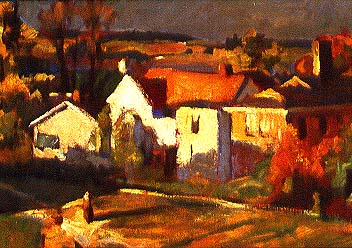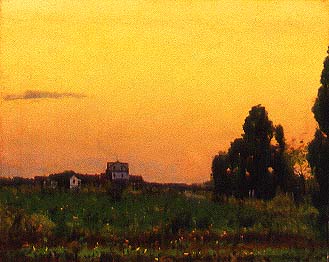

November Issue 1999
Exhibit at SC State Museum Explores the 20th Century in S.C. Art
 August Cook
August Cook
One hundred years, 100 artists, 100 stories -- and a multitude of images. That is what the South Carolina State Museum in Columbia, SC, will present in 100 Years/100 Artists: Views of the 20th Century in South Carolina Art.
The exhibit opened Oct. 29 and can be seen until Mar. 19, 2000 in the Lipscomb Art Gallery, the South Carolina Connections Gallery and on the museum grounds.
The 1900s began with pleasing landscapes and works showing Southern life. Then came: The Charleston Renaissance. The rise of professionalism and of university art programs. Joining - and influencing -- the national and international art scenes. Self-taught artists. "Cutting edge" craft artists. And, of course, Jasper Johns, "the catalyst for change in American art," says State Museum Art Curator Robin Waites.
The artists in the show were selected by a team consisting of Sharon Campbell, an independent curator from Greenville; David Houston, director of the Rudolph E. Lee Gallery, Clemson University; Polly Laffitte, formerly chief art curator at the State Museum; Frank Martin, curator at the I.P. Stanback Museum, S.C. State University; Nina Parris, former curator at the Columbia Museum of Art: and Martha Severens, curator at the Greenville County Museum of Art.
 Gilbert Gaul
Gilbert Gaul
The exhibit is divided into five time periods representing trends over the century. "We started with basic representational art: landscapes, aesthetically pleasing works that represent a romantic view of life in the South," Waites says. Among the artists important between 1900 and 1920 were Edwin Harleston, Edward Gay, William Aiken Walker and Ann Cadwallader Coles.
The 1920s and '30s was the time of the Charleston Renaissance. Artists included Alfred Hutty, Elizabeth O'Neill Verner, Alice R.H. Smith and Anna Heyward Taylor. "They focused on Lowcountry scenes, but you could see a national influence," Waites says. Some artists, such as Laura Glenn Douglas and William Henry Johnson, studied outside the U.S.
By the 1940s and '50s, many influences were beginning to be felt. "Real solid artist groups," such as the S.C. Artists Guild, were formed, Waites says. Artists such as William Halsey and J. Bardin began producing abstract work. Edmund Yaghjian began infusing social commentary in representational art. Jasper Johns, who left SC for New York in 1952, was coming into his own.
Much of the exciting work of the 1960s and 1970s grew out of the 1950s when college art programs became better established, Waites says. Another important development was the founding of the SC Arts Commission in 1967. It helped support a growing number of professional artists through fellowships and grants and by exhibiting and collecting art.
SC art during the period was "very diverse" and was beginning to reflect the national mainstream, Waites says. Philip Mullen of the University of South Carolina was internationally recognized for his abstract painting. Sam Wang of Clemson University did "really innovative work in photography." But the influence of Sam Doyle, whose paintings showed black life on his native St. Helena Island, also was felt. He became one of the best-known self-taught artists in the nation, Waites says.
During the 1980s and '90s the state's art horizon has continued to expand. Boundaries have blurred and a plethora of styles mix in an age of pluralism in the arts.
Photographer Phil Moody, a native of Scotland, is one of a number of international artists who have become influential in SC. But it has also been a time when Southern crafts have come to be recognized as fine art. Among the artists are basketmakers Mary Jackson and Clay Burnette and potters Sara Ayers and Steve Ferrell.
The artists in the show are a diverse group, Waites says. Some spent their lives here. Others blossomed after they left SC. Many were influential as teachers as well as artists. A number are South Carolinians by choice. Several worked in the state only briefly but did important work here.
"This is not to say the artists in the show are the only significant artists in SC at this time, but they are the ones who had a strong impact," Waites says. "We hope the exhibit will initiate a healthy, creative dialogue concerning art in SC in the 20th century."
This exhibit is part of Views From the Edge of the Century, a project of the South Carolina Arts Commission and Bank of America. Special funding is provided by the National Endowment for the Arts and Palmer Memorial Chapel.
For further information check our SC Institutional Gallery listings or call the museum at 803/898-4921.
Views from The Edge of the Century, Statewide Arts Celebration Features 37 Exhibitions and Projects in 16 Counties
Views from the Edge of the Century, a two-year celebration of South Carolina's contributions to the visual arts officially kicked off in Feb., 1999 and continued this fall with exhibitions opening in Greenville, Anderson, Orangeburg and Due West in Sept.. Throughout 1999 and 2000, thirty-two visual arts presenters across the state will participate, with each exhibition or project in the series focusing on a specific aspect or period of the state's visual arts heritage.
"We believe that the end of the century and the beginning of the new millennium is a perfect opportunity to recognize the visual arts in SC in a significant way," states Harriett Green, visual arts director of the SC Arts Commission. "Our visual arts community is incredibly rich and diverse. That fact makes a project of this scope especially exciting."
The Views project runs through Dec. 2000, and ranges from a series of solo exhibitions at the Greenville County Museum of Art, the Columbia Museum of Art, Spartanburg County Museum of Art, Milliken Gallery at Converse College, Sumter Gallery of Art and the Self Family Arts Center; to an exploration of image, media and technology at the I.P. Stanback Museum at SC State University in Orangeburg; to a survey exhibition which traces important developments in the visual arts in SC over the last one hundred years at the SC State Museum.
Views represents the most comprehensive visual arts project in the state's history, providing South Carolinians and visitors with an opportunity to see and learn about art and artists whose works are forever linked with the state's history. Not since the states Tricentennial celebration in 1970 has there been any attempt to showcase the visual arts through a partnership effort among the state's most active museums and galleries.
"By looking at the past, present and towards the future in this project," states Green, "We hope Views will provide a meaningful context in which we may examine the overall impact of the history of art on contemporary culture in our state."
Views from the Edge of the Century is a project of the South Carolina Arts Commission and Bank of America and is funded in part by a grant from the National Endowment for the Arts.
For more information on Views from the Edge of the Century, contact Harriett Green, Director of Visual Arts at 803/734-8762 or by e-mail at greenhar@arts.state.sc.us.
Mailing Address: Carolina Arts, P.O. Drawer
427, Bonneau, SC 29431
Telephone, Answering Machine and FAX: 843/825-3408
E-Mail: carolinart@aol.com
Subscriptions are available for $18 a year.
Carolina Arts
is published monthly by Shoestring
Publishing Company, a subsidiary of PSMG, Inc.
Copyright© 1999 by PSMG, Inc., which published Charleston
Arts from July 1987 - Dec. 1994 and South Carolina Arts
from Jan. 1995 - Dec. 1996. It also publishes Carolina Arts
Online, Copyright© 1999 by PSMG, Inc. All rights reserved
by PSMG, Inc. or by the authors of articles. Reproduction or use
without written permission is strictly prohibited. Carolina
Arts is available throughout North & South Carolina.